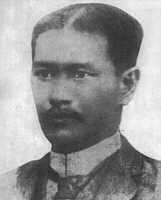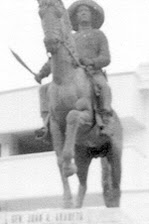The Ilonggo Martyrs of Martial Law
(DinggolAranetaDivinagracia - IlonggoNationMovement)

Prologue: “After Martial Law was declared on Sept. 21, 1972; sooo many of our “Kababayan” cowered in fear and mostly shouted "Alleluia", while many others sang to the tune of "Que sera, sera!" But a few young idealistic brave souls sacrificed their schooling, left the comforts of homes, armed themselves and went to the hills to fight the cruel and oppressive regime.” --dinggol.d~~~
A prelude to the declaration of Martial Law
During the decade of the 1960s, two (2) distinguished college Professors at the University of the Philippines (UP) -Diliman in Quezon City founded movements that would later change the course of Philippine history, namely: Jose Maria Sison and Nurullaji "Nur" Misuari.
The Kabataang Makabayan (KM)

On November 30, 1964, during Andres Bonifacio Day, U.P. Professor Jose Maria Sison established the KM or the Kabataang Makabayan, and as its founding Chairman, Sison emphasized the continuity of the Andres Bonifacio's Philippine Revolution of 1896. He even invited the famed Nationalist Senator Lorenzo M. Tañada who gave the closing speech at the KM's first-ever national congress and was honored as their consultant and honorary member.
The initial members of KM were mostly from the Students' Cultural Association of UP (SCAUP) in the University of the Philippines. Jose Maria Sison envisioned the youth group as revolutionaries who would later establish the Philippines as a country led by the working class instead of usual oligarchic politicians.
When Mr. Sison re-established the Communist Party of the Philippines in 1968 as a consequence of the dismal failure of the old “Partido Komunista ng Pilipinas”, the New People's Army (NPA) under Bernabe Buscayno with Nome-de-Guerre “Kumander Dante” --was organized as its military wing; the Kabataang Makabayan (KM) then became the NPA's youth arm. It was also one of the groups that later established the National Democratic Front of the Philippines (NDFP).

Mr. Jose Maria Sison authored and published two (2) books; the Struggle for National Democracy and the Movement for the Advancement of Nationalism (MAN). These books clearly explain the ills and maladies that confronts Filipino society, that was brought about by the continuous stranglehold of the U.S. imperialism, feudalism and bureaucrat capitalism; the root causes and the solutions to benefit all, the present and the future generations. Obviously, the basic nationalistic tenor of the two (2) books, touched the patriotic fervor of many idealistic labor workers, peasants, students,and young professionals. As a matter of fact, the two books were considered the bible in the education of cadres and mass activists in the course of the First Quarter Storm of the 1970s.
The Moro National Liberation Front (MNLF)

Likewise, in March of 1968, the alleged massacre of at least 23 Jabidah trainees on Corregidor island for the Sabah Mission sparked the Muslim rebellion in the south and gave birth to the Moro National Liberation Front (MNLF) founded by University of the Philippines (UP) Professor Nurullaji "Nur" Misuari of Jolo, Sulu in Mindanao.
The Declaration of Martial Law

As the country was at the brink of total anarchy, and Malacañang had to contend with both the left and the right of the political spectrum; likewise, with the ongoing Muslim rebellion in Mindanao, on September 21, 1972 President Ferdinand Edralin Marcos began the revolution from the center and declared martial law "Para sa Ikaunlad ng Bayan, Disciplina ang Kailangan" as he proudly announced --the birth of the "New Society".

Secretary of Defense Juan Ponce Enrile and AFP ViceChief of Staff General Fidel Ramos were then both tasked as the Administrator and the Implementer of the martial law regime, respectively.
The Light-a-Fire-Movement

During the early 1980s,a group of prominent people decided that violence was the only solution against "abuses" of the Martial Law --established a group known as the "Light-A-Fire Movement". In Metro Manila, the core groups operatives of the Light-A-Fire Movement based in the Philippines, were businessman Eduardo Olaguer, professor Gaston Ortigas of the Asian Institute of Management (AIM) and Ester Jimenez, mother of Jim Paredes (of the Apo Hiking Society fame). In the US, its members were Filipino exiles and Filipino-Americans, mostly unnamed but led mainly by Heherson Alvarez, Raul Daza, Bonifacio Gillego and Charles Avila, along with a naturalized American citizen, a Greek native, Steven Psinakis (husband of Precy Lopez of the ABS-CBN Lopez clan).

The Light-A-Fire Movement perpetrated many horrible acts of bombings in Metro Manila in the early 1980s, and blamed it all on the government. On September 12, 1980, bombs went off in Makati Commercial District, one badly damaging the huge Rustan's mall. The explosion at Rustan’s injured 70 people and killed an American tourist. On October 4, 1980, more blasts rocked the Philippine Plaza, Century Park Sheraton, and Manila Peninsula hotels, all in Metro Manila.

(Photo: Doris Nuval Baffrey)
On October 19, 1980, Doris Nuval Baffrey, a Filipina married to an American, detonated an explosive at the Phil. International Convention Center or (PICC) along Roxas Blvd.while President Ferdinand Marcos was addressing an international conference of the American Society of Travel Agents. Ms. Doris Nuval Baffrey and 15 other people were arrested in connection with the PICC bombing. They were all convicted and sentenced to die by electric chair in 1984. Fortunately for them, due to several postponements, they were later spared after the fall of the Marcos regime.
The Butchers in the military and their Safe-houses
Meanwhile, the dreaded butchers in the military intelligence group had their heydays in their safe-houses. They randomly arrest, torture, and even salvage many suspected political detractors; including many members of students, peasants, professionals, and labor activist groups who were opposed to Malacañang.

(Photo: Young PMA officers led by Gringo Honasan and by Red Kapunan)
This included some sectors in the military establishment led by the Philippine Military Academy or (PMA) young officers, who would later conscientiously turn around to advocate reforms in the AFP.
The young Ilonggo Martyrs of Martial Law

(L-R): John (Age 22) and his elder brother Edward Dela Fuente (Age 30)
At the height of the Marcos’ brutal reign in 1983, John Herbert Dela Fuente (22), a young Ilonggo student activist, was shot dead at close range while asleep at a relative’s house in Jaro, Iloilo City.
The local constabulary reported that the killing was the product of an “armed encounter” but people know he was really “salvaged” – executed for his activism and support to the fight against the tyranny of a dictator.
His elder brother, Edward Oliver L. Dela Fuente, a student of Central Philippine University (CPU) and a former editor-in-chief of the student publication Central Echo, wrote a poem entitled “Epilogue” to commemorate John’s death, swearing to live on and continue his fallen brother’s plight for the freedom of the country.
Edward and John were the sons of two leaders of the Baptist Church in Iloilo; Johnny and Lucy L. Dela Fuente. Both of them regularly attended church services, and the eldest Dela Fuente brother was also a former president of the National Baptist Youth of the Philippines.






















































